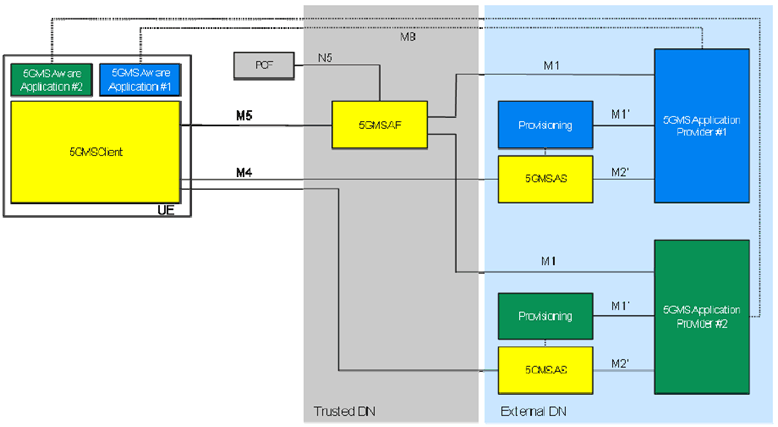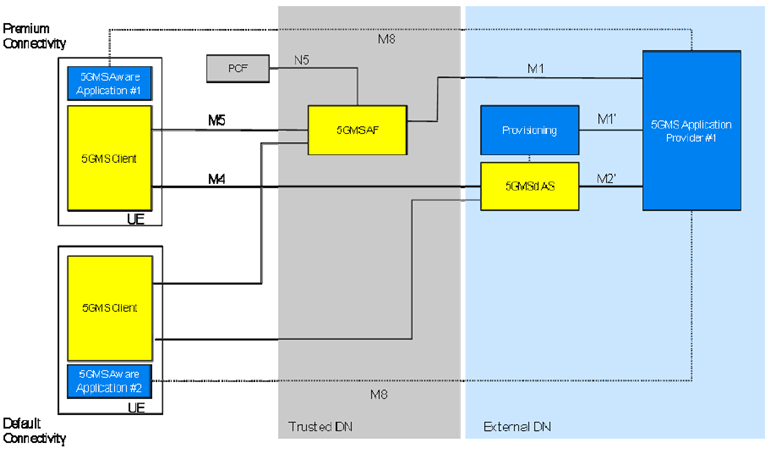Content for TS 26.501 Word version: 18.6.0
1…
4…
4.0.6…
4.1…
4.2…
4.2.2…
4.3…
4.4
4.5…
4.6…
4.7…
4.7.4…
4.8
4.9…
4.10…
5…
5.2…
5.2.4
5.2.5…
5.3…
5.3.2…
5.4…
5.5…
5.6…
5.7…
5.7.4…
5.7.8
5.8…
5.10…
5.10.5…
5.10.6…
5.11…
5.12…
5.12.4…
5.12.5…
6…
6.2…
6.2.2.2…
6.2.3…
6.3…
6.4…
6.8…
6.9…
6.9.5…
6.9.7
7…
8…
9…
A…
A.4…
A.8
A.9
A.10
A.11
A.12
A.13
A.14
A.15…
A.15.3…
B…
B.3
C…
C.3
C.4
C.5
D…
E…
E Collaboration models for per-application authorisation
E.1 Introduction
E.2 UE hosting multiple applications
E.3 Applications with multiple subscription levels
$ Change history
E Collaboration models for per-application authorisation |R18| p. 228
E.1 Introduction p. 228
Operation of certain 5GMS services may include an SLA between the Application Provider and the 5GMS System provider. In this context, "Per-application authorisation" refers to scenarios where one or more 5GMS-Aware Application is hosted on the same UE and can access services only from the associated 5GMS Application Provider.
The 5GMS System provider may offer one common 5GMS AF serving all 5GMS Application Providers or separate logical 5GMS AFs, each serving a single 5GMS Application Provider.
In the following, two example scenarios are described:
- A single UE hosting multiple 5GMS-Aware Applications from different 5MGS Application Providers.
- A single 5GMS Application Provider offers different subscription levels.
E.2 UE hosting multiple applications p. 229
This collaboration scenario focuses on cases where one or more 5GMS-Aware Applications are hosted on the same UE and are using the same 5GMS Client. This may be the case when the Media Session Handler in the 5GMS Client is provided as a common Operating System service. The Media Session Handler in the 5GMS Client supports isolation between different 5GMS-Aware Application contexts.

Each 5GMS-Aware Application uses an M8 reference point instance to connect to its 5GMS Application Provider.
The 5G System provider offers a common 5GMS AF within the Trusted DN. The 5GMS AF supports request and provider isolation so that 5GMS Application Provider #1 and #2 do not interfere with each other.
EXAMPLE 1:
5GMS Application Provider #1 has agreed different charging conditions from 5GMS Application Provider #2. The 5GMS System ensures that only 5GMS-Aware Application #1 can benefit from the conditions agreed with 5GMS Application Provider #1.
EXAMPLE 2:
5GMS-Aware Application #1 is entitled to receive higher network QoS than 5GMS-Aware Application #2.
E.3 Applications with multiple subscription levels p. 230
This collaboration scenario focuses on cases where a 5GMS Application Provider offers multiple subscription levels to its consumers, for example the user of 5GMS-Aware Application #1 is entitled to the "Premium Connectivity" subscription level while the user of 5GMS-Aware Application #2 is entitled only to the "Default Connectivity" level.

Each 5GMS-Aware Application uses an M8 reference point instance to connect to its 5GMS Application Provider. The 5GMS Application Provider is aware about the different user subscription levels.
The 5G System provider offers a common 5GMS AF within the Trusted DN. Using an appropriate authorisation mechanism, the 5GMS AF determines that 5GMS-Aware Application #1 is entitled to higher bit rates than 5GMS-Aware Application #2.